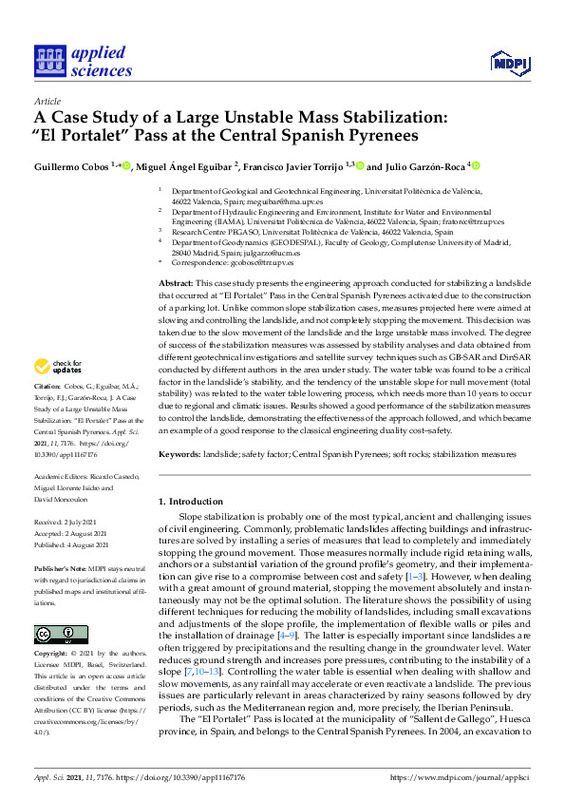JavaScript is disabled for your browser. Some features of this site may not work without it.
Buscar en RiuNet
Listar
Mi cuenta
Estadísticas
Ayuda RiuNet
Admin. UPV
A Case Study of a Large Unstable Mass Stabilization: "El Portalet" Pass at the Central Spanish Pyrenees
Mostrar el registro sencillo del ítem
Ficheros en el ítem
| dc.contributor.author | Cobos Campos, Guillermo
|
es_ES |
| dc.contributor.author | Eguibar Galán, Miguel Ángel
|
es_ES |
| dc.contributor.author | Torrijo, F.J.
|
es_ES |
| dc.contributor.author | Garzón-Roca, Julio
|
es_ES |
| dc.date.accessioned | 2022-05-24T18:05:01Z | |
| dc.date.available | 2022-05-24T18:05:01Z | |
| dc.date.issued | 2021-08 | es_ES |
| dc.identifier.uri | http://hdl.handle.net/10251/182872 | |
| dc.description.abstract | [EN] This case study presents the engineering approach conducted for stabilizing a landslide that occurred at "El Portalet" Pass in the Central Spanish Pyrenees activated due to the construction of a parking lot. Unlike common slope stabilization cases, measures projected here were aimed at slowing and controlling the landslide, and not completely stopping the movement. This decision was taken due to the slow movement of the landslide and the large unstable mass involved. The degree of success of the stabilization measures was assessed by stability analyses and data obtained from different geotechnical investigations and satellite survey techniques such as GB-SAR and DinSAR conducted by different authors in the area under study. The water table was found to be a critical factor in the landslide's stability, and the tendency of the unstable slope for null movement (total stability) was related to the water table lowering process, which needs more than 10 years to occur due to regional and climatic issues. Results showed a good performance of the stabilization measures to control the landslide, demonstrating the effectiveness of the approach followed, and which became an example of a good response to the classical engineering duality cost-safety. | es_ES |
| dc.description.sponsorship | This research did not receive any specific grant from funding agencies in the public, commercial, or not-for-profit sectors. The authors fully acknowledge the financial support provided by the Department of Geological and Geotechnical Engineering of the UPV. | es_ES |
| dc.language | Inglés | es_ES |
| dc.publisher | MDPI AG | es_ES |
| dc.relation.ispartof | Applied Sciences | es_ES |
| dc.rights | Reconocimiento (by) | es_ES |
| dc.subject | Landslide | es_ES |
| dc.subject | Safety factor | es_ES |
| dc.subject | Central Spanish Pyrenees | es_ES |
| dc.subject | Soft rocks | es_ES |
| dc.subject | Stabilization measures | es_ES |
| dc.subject.classification | INGENIERIA HIDRAULICA | es_ES |
| dc.subject.classification | INGENIERIA DEL TERRENO | es_ES |
| dc.title | A Case Study of a Large Unstable Mass Stabilization: "El Portalet" Pass at the Central Spanish Pyrenees | es_ES |
| dc.type | Artículo | es_ES |
| dc.identifier.doi | 10.3390/app11167176 | es_ES |
| dc.rights.accessRights | Abierto | es_ES |
| dc.contributor.affiliation | Universitat Politècnica de València. Departamento de Ingeniería Hidráulica y Medio Ambiente - Departament d'Enginyeria Hidràulica i Medi Ambient | es_ES |
| dc.contributor.affiliation | Universitat Politècnica de València. Departamento de Ingeniería del Terreno - Departament d'Enginyeria del Terreny | es_ES |
| dc.description.bibliographicCitation | Cobos Campos, G.; Eguibar Galán, MÁ.; Torrijo, F.; Garzón-Roca, J. (2021). A Case Study of a Large Unstable Mass Stabilization: "El Portalet" Pass at the Central Spanish Pyrenees. Applied Sciences. 11(16):1-17. https://doi.org/10.3390/app11167176 | es_ES |
| dc.description.accrualMethod | S | es_ES |
| dc.relation.publisherversion | https://doi.org/10.3390/app11167176 | es_ES |
| dc.description.upvformatpinicio | 1 | es_ES |
| dc.description.upvformatpfin | 17 | es_ES |
| dc.type.version | info:eu-repo/semantics/publishedVersion | es_ES |
| dc.description.volume | 11 | es_ES |
| dc.description.issue | 16 | es_ES |
| dc.identifier.eissn | 2076-3417 | es_ES |
| dc.relation.pasarela | S\443767 | es_ES |
| dc.contributor.funder | Universitat Politècnica de València | es_ES |
| dc.subject.ods | 09.- Desarrollar infraestructuras resilientes, promover la industrialización inclusiva y sostenible, y fomentar la innovación | es_ES |
| dc.subject.ods | 11.- Conseguir que las ciudades y los asentamientos humanos sean inclusivos, seguros, resilientes y sostenibles | es_ES |








